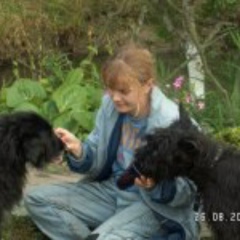Вспоминает подруга Тани Савичевой
"...С Таней мы были знакомы лет с шести, до школы. Мы жили рядом: она в доме 13, а мы в доме 3 по 1-й линии Васильевского острова. Вместе бегали в керосиновую лавку. Нам нравился запах. Тогда керосин продавался не в бутылях, а был налит в огромную ванну, в которой переливался всеми цветами. И она смотрела завороженно, и я».
Еще обе любили сладкое: «В доме № 13 была булочная, ее, кстати, закрыли только в 2004 году. Очень хорошая. Она принадлежала отцу Тани. Потом ее отняли, а отец вскоре скончался. У меня дед тоже владел пекарней и кондитерскими. Мы очень хорошо в этом деле обе разбирались — приходили туда и обсуждали бублики-баранки…»
Школа № 16, в которой они учились, во время войны стала военным госпиталем. Поэтому сначала детей собирали в полуподвальном помещении красного уголка дома 1/3 по 2-й линии. О своей блокадной учительнице Наталья Федоровна много рассказывала внучке Ане, а та написала сочинение, вошедшее в книгу «Дети войны». Пожилая учительница во время бомбежек уводила детей в бомбоубежище Академии художеств, прижимая к себе самых маленьких. «Стойкий оловянный солдатик», она всегда приносила на урок свою маленькую собачку. На перемене собачка вставала на задние лапы и выжидательно смотрела на хозяйку, а та незаметно давала ей кусочек хлеба — размером с грецкий орех. Собачка просила еще. Дети к тому времени уже голодали, но никто не возмущался. Старая учительница была одинока, собака была для нее как ребенок. Однажды учительница не пришла… Потом дети узнали, что кто-то в парадной вырвал собачку из ее рук. Через три дня женщина умерла от горя. От голода тогда еще не умирали.
Весной 1942 года выживших перевели в школу № 21. «Мы хотели к августу пройти весь курс 4-го класса, который пропустили. Занятия были усиленные, — вспоминает Наталья Федоровна. — Нас водили в столовую на 10-й линии. Когда мы в первый раз пошли туда, взявшись за руки, женщина на улице, увидев нас, заплакала: «Дети! Выжили! Дети!» Город тогда был безлюдный, каждый сидел в своей клетке и умирал, а тут — дети!»
"...С Таней мы были знакомы лет с шести, до школы. Мы жили рядом: она в доме 13, а мы в доме 3 по 1-й линии Васильевского острова. Вместе бегали в керосиновую лавку. Нам нравился запах. Тогда керосин продавался не в бутылях, а был налит в огромную ванну, в которой переливался всеми цветами. И она смотрела завороженно, и я».
Еще обе любили сладкое: «В доме № 13 была булочная, ее, кстати, закрыли только в 2004 году. Очень хорошая. Она принадлежала отцу Тани. Потом ее отняли, а отец вскоре скончался. У меня дед тоже владел пекарней и кондитерскими. Мы очень хорошо в этом деле обе разбирались — приходили туда и обсуждали бублики-баранки…»
Школа № 16, в которой они учились, во время войны стала военным госпиталем. Поэтому сначала детей собирали в полуподвальном помещении красного уголка дома 1/3 по 2-й линии. О своей блокадной учительнице Наталья Федоровна много рассказывала внучке Ане, а та написала сочинение, вошедшее в книгу «Дети войны». Пожилая учительница во время бомбежек уводила детей в бомбоубежище Академии художеств, прижимая к себе самых маленьких. «Стойкий оловянный солдатик», она всегда приносила на урок свою маленькую собачку. На перемене собачка вставала на задние лапы и выжидательно смотрела на хозяйку, а та незаметно давала ей кусочек хлеба — размером с грецкий орех. Собачка просила еще. Дети к тому времени уже голодали, но никто не возмущался. Старая учительница была одинока, собака была для нее как ребенок. Однажды учительница не пришла… Потом дети узнали, что кто-то в парадной вырвал собачку из ее рук. Через три дня женщина умерла от горя. От голода тогда еще не умирали.
Весной 1942 года выживших перевели в школу № 21. «Мы хотели к августу пройти весь курс 4-го класса, который пропустили. Занятия были усиленные, — вспоминает Наталья Федоровна. — Нас водили в столовую на 10-й линии. Когда мы в первый раз пошли туда, взявшись за руки, женщина на улице, увидев нас, заплакала: «Дети! Выжили! Дети!» Город тогда был безлюдный, каждый сидел в своей клетке и умирал, а тут — дети!»
Tanya Savicheva's friend recalls
"... We had known Tanya from about six years before school. We lived nearby: she is in house 13, and we are in house 3 on the 1st line of Vasilievsky Island. We ran to the kerosene shop together. We liked the smell. Then kerosene was sold not in bottles, but was poured into a huge bathtub, in which it shimmered with all the colors. And she looked fascinated, and I. "
Both also loved sweets: “There was a bakery in house No. 13, which, by the way, was closed only in 2004. Very good. It belonged to Tanya's father. Then she was taken away, and her father died soon after. My grandfather also owned a bakery and pastry shops. We both understood very well in this matter - we came there and discussed bagels-bagels ... "
School No. 16, where they studied, became a military hospital during the war. Therefore, at first the children were gathered in the basement of the red corner of the house 1/3 along the 2nd line. Natalya Fedorovna told her granddaughter Anya a lot about her siege teacher, and she wrote an essay that was included in the book "Children of War". An elderly teacher, during the bombing, took the children to the bomb shelter of the Academy of Arts, hugging the little ones to her. The Steadfast Tin Soldier, she always brought her little dog to class. At recess, the dog stood up on its hind legs and looked expectantly at the hostess, and she discreetly gave her a piece of bread - the size of a walnut. The dog asked for more. The children were already starving by that time, but no one was indignant. The old teacher was lonely, the dog was like a child to her. One day the teacher did not come ... Then the children learned that someone in the front door had snatched the dog out of her hands. Three days later, the woman died of grief. They did not die of hunger then.
In the spring of 1942, the survivors were transferred to school number 21. “We wanted to complete the entire 4th grade course by August, which we missed. Classes were intensified, - recalls Natalya Fedorovna. - We were taken to the dining room on the 10th line. When we went there for the first time, hand in hand, a woman on the street, seeing us, cried: “Children! Survived! Children!" The city was then deserted, everyone was sitting in his own cage and dying, and here - children! "
"... We had known Tanya from about six years before school. We lived nearby: she is in house 13, and we are in house 3 on the 1st line of Vasilievsky Island. We ran to the kerosene shop together. We liked the smell. Then kerosene was sold not in bottles, but was poured into a huge bathtub, in which it shimmered with all the colors. And she looked fascinated, and I. "
Both also loved sweets: “There was a bakery in house No. 13, which, by the way, was closed only in 2004. Very good. It belonged to Tanya's father. Then she was taken away, and her father died soon after. My grandfather also owned a bakery and pastry shops. We both understood very well in this matter - we came there and discussed bagels-bagels ... "
School No. 16, where they studied, became a military hospital during the war. Therefore, at first the children were gathered in the basement of the red corner of the house 1/3 along the 2nd line. Natalya Fedorovna told her granddaughter Anya a lot about her siege teacher, and she wrote an essay that was included in the book "Children of War". An elderly teacher, during the bombing, took the children to the bomb shelter of the Academy of Arts, hugging the little ones to her. The Steadfast Tin Soldier, she always brought her little dog to class. At recess, the dog stood up on its hind legs and looked expectantly at the hostess, and she discreetly gave her a piece of bread - the size of a walnut. The dog asked for more. The children were already starving by that time, but no one was indignant. The old teacher was lonely, the dog was like a child to her. One day the teacher did not come ... Then the children learned that someone in the front door had snatched the dog out of her hands. Three days later, the woman died of grief. They did not die of hunger then.
In the spring of 1942, the survivors were transferred to school number 21. “We wanted to complete the entire 4th grade course by August, which we missed. Classes were intensified, - recalls Natalya Fedorovna. - We were taken to the dining room on the 10th line. When we went there for the first time, hand in hand, a woman on the street, seeing us, cried: “Children! Survived! Children!" The city was then deserted, everyone was sitting in his own cage and dying, and here - children! "
У записи 15 лайков,
4 репостов,
461 просмотров.
4 репостов,
461 просмотров.
Эту запись оставил(а) на своей стене Евгений Марон



































